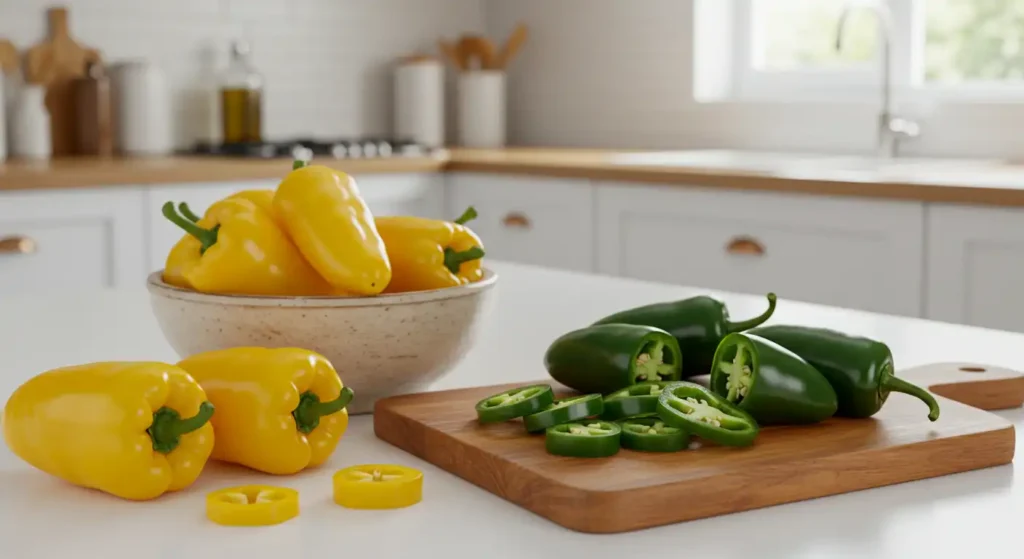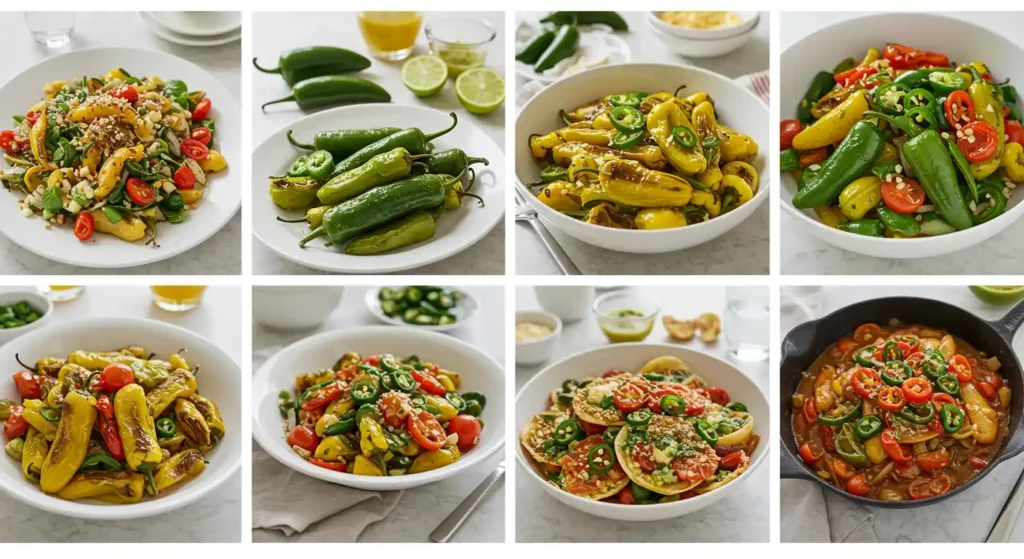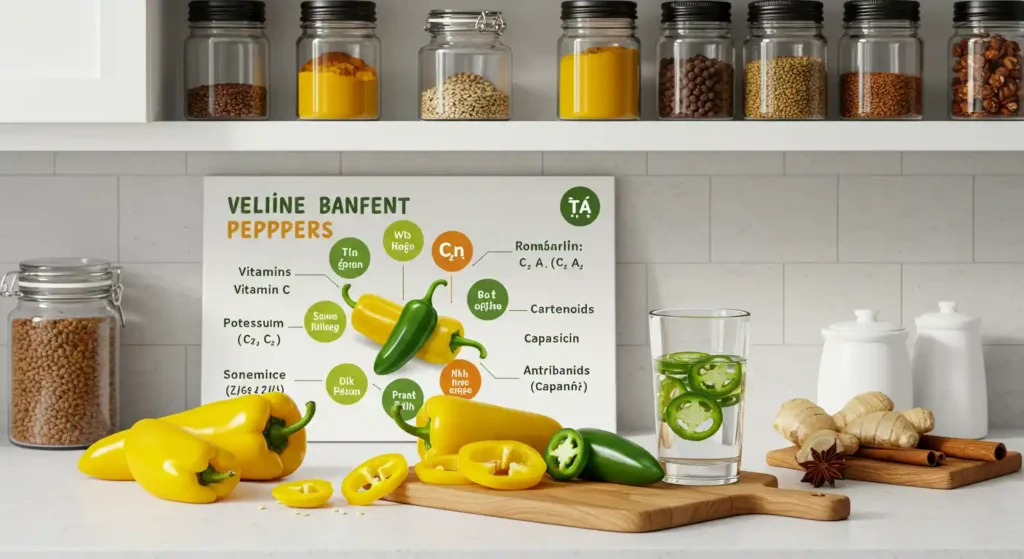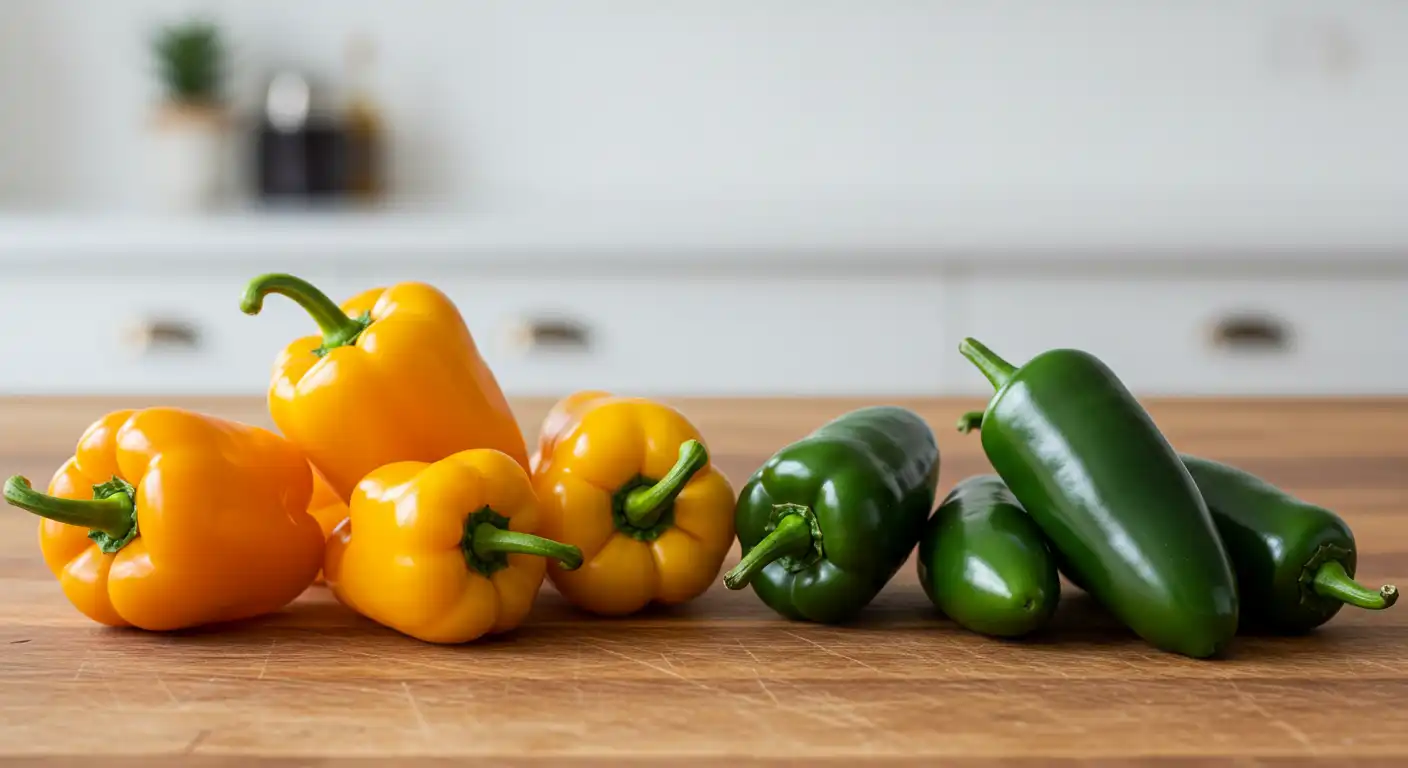Have you ever stood in the grocery store, gazing at the colorful array of peppers, and wondered, “are banana peppers like jalapeños?” You’re not alone! Many people are curious about these two popular peppers. They look a bit similar, but don’t let that fool you. This article will dive deep into the differences. We’ll explore their flavors, heat levels, and culinary uses. Get ready for a spicy comparison, friends!
Initial Overview: Understanding the Banana Pepper and the Jalapeño
Banana peppers and jalapeños are both common peppers, but they have very distinct characteristics. Understanding these differences is essential for any home cook. They each bring something unique to the table. One is sweet and tangy, while the other is more fiery. Let’s break it down further.
Banana Pepper Basics: Sweet, Tangy, and Mild
Banana peppers, also known as yellow wax peppers, are typically mild. They have a bright yellow color when ripe. Their shape is long and slightly curved, like a banana. This is where they get their name, of course! These peppers are known for their mild, slightly sweet flavor. They also have a subtle tanginess that can be very appealing. Their heat is minimal, often registering low on the Scoville scale. Therefore, they’re a great option for those who prefer a gentle kick.
Jalapeño Highlights: Fiery, Earthy, and Bold
Jalapeños, on the other hand, are famous for their noticeable heat. These peppers are usually green, though they can turn red when fully ripe. Jalapeños are shorter and thicker than banana peppers. Their flavor is often described as earthy and slightly grassy. They pack a medium level of heat, providing a significant spice. Therefore, they are very popular in many cuisines for their robust flavor.
Flavor Profiles: A Tale of Two Tastes
Banana peppers and jalapeños differ greatly in flavor. Banana peppers are known for their mild, slightly sweet, and tangy taste. This makes them perfect for pickling and adding a subtle zing to dishes. Jalapeños offer a more intense flavor. They have an earthy taste and a significant heat that adds a bold kick to many recipes. These distinct flavor profiles make each pepper suitable for different culinary uses.
Banana Pepper’s Sweet and Tangy Side
The subtle sweetness of banana peppers makes them incredibly versatile. Their tanginess adds a refreshing edge to salads, sandwiches, and antipasto platters. You can also pickle them and enjoy them as a condiment. For those who aren’t fans of heat, they offer a flavorful alternative.
Jalapeño’s Earthy and Fiery Character
Jalapeños provide a distinctly fiery flavor that many find addictive. Their earthy taste adds depth to salsas, sauces, and Tex-Mex dishes. If you crave heat, the jalapeño is likely your pepper of choice. They’re also great for roasting or grilling, which brings out their smoky notes.
Heat Levels: From Mild to Medium
The heat levels are a significant difference. Banana peppers are very mild. Jalapeños, however, bring a medium level of heat. The Scoville scale measures the heat of chili peppers. Understanding this scale helps compare the spiciness of the two. This difference is essential for choosing the right pepper in your cooking.
Banana Peppers: A Gentle Warmth
Banana peppers typically range from 0 to 500 Scoville Heat Units (SHU). This is incredibly mild, even negligible for most people. They add a touch of flavor without the burn, therefore making them ideal for those who are sensitive to spice.
Jalapeños: A Noticeable Kick
Jalapeños range from 2,500 to 8,000 SHU. This is a significant jump from banana peppers. Jalapeños offer a medium level of heat. They are spicy enough to provide a kick, but not so intense as to be overwhelming.
Appearance: Shape, Size, and Color

Visually, banana peppers and jalapeños differ. Banana peppers are long, slender, and curved like bananas. They are usually bright yellow when ripe. Jalapeños are shorter, thicker, and typically green. These visual differences help you quickly identify them in the grocery store.
Banana Pepper’s Distinctive Shape
Banana peppers are long and slender. They have a slight curve that resembles a banana. These peppers are typically 4 to 6 inches in length. Their bright yellow color makes them easy to spot, often used in pickles and sandwiches.
Jalapeño’s Sturdy Form
Jalapeños are shorter and thicker. They usually measure 2 to 4 inches long. Their color ranges from green to red, but you usually see them in their green form. Jalapeños also have a smoother, slightly glossier skin.
Culinary Uses: Where They Shine
Banana peppers and jalapeños find their way into various dishes. Banana peppers are often pickled. They’re added to sandwiches and salads to add a sweet and tangy kick. Jalapeños, however, are used in spicy dishes. They add heat to salsas, sauces, and Tex-Mex recipes.
Banana Pepper Culinary Adventures
The mildness of banana peppers makes them versatile. They work well in pickled form, adding a pleasant crunch and tang to dishes. They are also delicious when added to pizzas, salads, or antipasto platters. Banana peppers are even good stuffed, though you won’t get that same fiery kick.
Jalapeño’s Fiery Recipes
Jalapeños are an essential ingredient in many Mexican and Tex-Mex dishes. They bring heat to salsas, guacamole, and chili. Jalapeños can be roasted, grilled, or added fresh to recipes. The options are vast! They are even delicious when stuffed with cheese and wrapped in bacon.
Pickling and Preserving: A Comparison

Both banana peppers and jalapeños are commonly pickled. Pickling is a popular way to preserve them. However, the results and uses of these pickled peppers are quite different. The sweetness and mildness of pickled banana peppers is what makes them so popular. Pickled jalapeños, on the other hand, add intense heat and flavor.
Pickled Banana Peppers: Sweet and Tangy Delights
Pickled banana peppers are sweet, tangy, and a little bit crunchy. They’re commonly found in deli sandwiches and antipasto platters. These pickled peppers are a great addition to a charcuterie board. The mild flavor makes them appealing to a wide range of tastes.
Pickled Jalapeños: Spicy and Bold
Pickled jalapeños pack a significant punch. They’re perfect for adding a fiery kick to nachos, tacos, and various Tex-Mex dishes. The pickled jalapeños keep a bit of their signature earthy flavor. Their heat is very noticeable, making them favorites for those who like spicy food.
Nutritional Differences: What’s Inside?
Both banana peppers and jalapeños have good nutritional value. They offer vitamins, minerals, and fiber. However, some minor differences exist in their nutritional profiles. These differences are slight, but important if you’re monitoring your intake of certain nutrients.
Banana Pepper Nutritional Value
Banana peppers are low in calories and provide a good source of Vitamin C. They contain small amounts of other vitamins and minerals. These peppers are beneficial for those looking to add flavor without the calories.
Jalapeño Nutritional Value
Jalapeños are also low in calories. They are a good source of Vitamin C and Vitamin B6. They also contain some Vitamin A, which is great for healthy vision. Both peppers provide a nutritional boost.
Growing Conditions: Where They Thrive
The growing conditions for banana peppers and jalapeños are fairly similar. They both prefer warm climates. They need plenty of sunlight and well-drained soil. However, some small differences exist that might affect your gardening decisions.
Growing Banana Peppers
Banana peppers thrive in warm, sunny conditions. They require consistent watering and well-drained soil. These peppers mature relatively quickly. They are a great option for home gardeners, especially if you like a low-maintenance crop.
Growing Jalapeños
Jalapeños also prefer warm climates and plenty of sunshine. They require regular watering and well-drained soil to flourish. They may take slightly longer to mature than banana peppers. With the right conditions, they will still give you a good harvest.
A Hilarious Pepper Mishap
Okay, time for a quick chuckle! So, picture this: I was making a huge batch of chili for a family gathering. I thought I grabbed banana peppers to add some tang. I even proudly announced, “This will have a nice gentle sweetness!”. Well, it turns out I was holding jalapeños, and I didn’t realize it until my first bite. Let’s just say, it wasn’t sweet and gentle. Instead, my family got a “fiery surprise” that left everyone reaching for water! The moral of the story? Always double-check your peppers!
Final Tips: Choosing the Right Pepper for Your Needs
When choosing between banana peppers and jalapeños, consider your desired flavor and heat level. Banana peppers are perfect for mild, sweet, and tangy dishes. Jalapeños are ideal for spicy, flavorful dishes. Your preference will help you make the right choice every time.
When to Choose Banana Peppers
Select banana peppers if you want a mild, slightly sweet, and tangy flavor. They work well in salads, sandwiches, and antipasto. They are also a great option for pickling. Banana peppers are a delicious, mild choice.
When to Choose Jalapeños
Choose jalapeños if you crave heat and an earthy flavor. They are perfect for salsas, sauces, and Tex-Mex dishes. Jalapeños will bring a nice kick to any recipe that needs some added fire.

| Nutritional Benefits | Amount per 100g |
| Calories | 27 |
| Total Fat | 0.1g |
| Saturated Fat | 0g |
| Cholesterol | 0mg |
| Sodium | 13mg |
| Total Carbohydrate | 6.3g |
| Dietary Fiber | 2.6g |
| Total Sugars | 3.5g |
| Protein | 1g |
| Vitamin C | 143.7mg |
| Vitamin A | 134 IU |
| Potassium | 140 mg |
Frequently Asked Questions
Q: Can I substitute banana peppers for jalapeños?
A: Yes, you can substitute banana peppers for jalapeños, but be mindful of the difference in heat. If you use banana peppers, your dish will be much milder. You might need to add another source of heat if that’s what you want.
Q: How do you reduce the heat of a jalapeño?
A: Removing the seeds and membranes can significantly reduce the heat of a jalapeño. You can also soak them in water or milk to lessen the spiciness. Cooking them can also help to slightly reduce the heat.
Q: What is the Scoville scale?
A: The Scoville scale measures the heat of chili peppers. The measurement is expressed in Scoville Heat Units (SHU). The higher the SHU, the hotter the pepper. For example, banana peppers are on the very low end, and jalapeños are on the medium end of the scale.
Q: Are Banana Peppers Hot or Sweet? They are mild and sweet, with a slight tang that makes them an excellent choice for those who prefer subtle flavors in their dishes. Their sweetness pairs perfectly with savory and salty ingredients, creating a well-balanced taste that appeals to a wide range of palates.
Q: Are Banana Peppers Healthy to Eat? Yes, they are low in calories and high in Vitamin C and fiber.
